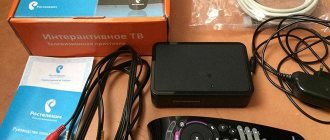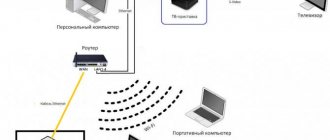With the release of the Federal Law “On Communications” in 2014, the state program “Elimination of the Digital Divide” (“EDD”) is gradually being implemented in Russian spaces from 2021. The project is intended to provide rural residents with a broadband connection through the introduction of free Wi-Fi in rural areas from Rostelecom.
The government plans to implement the program through the leading telecommunications company Rostelecom for one decade. The coverage of hard-to-reach rural areas with Wi-Fi access is moving at an accelerated pace. The provider plans to complete the ambitious project much ahead of schedule.
Providers in rural areas
The population density in many rural settlements is constantly falling - people are leaving to live in cities. Therefore, it is not profitable for Internet providers to build their networks in villages and towns . However, many residents in rural areas have hope that one day they will have access to high-speed Internet. Already today it can be offered by mobile operators.
But this connection method has several disadvantages:
- 3G and 4G networks are not deployed everywhere - you have to be content with the Internet at a “snail” speed;
- Mobile operators do not offer the most affordable tariffs - for large traffic packages you have to pay quite large sums;
- There is no unlimited traffic, at least with a speed limit - unlike traditional providers.
Also, in villages there is no access to ADSL technology, not to mention other technologies.
In large cities, they are already abandoning outdated telephone lines and connecting subscribers to high-speed optical networks. There is clearly inequality between residents of cities and rural settlements - the former can consume hundreds of gigabytes of information, while the latter are forced to access the Internet via cellular networks. The “Closing the Digital Divide” program allows us to solve this problem.
Connectivity technologies
The most common ways to bring Internet from Rostelecom to a private home:
- via telephone line (ADSL);
- using fiber optics (PON);
- wireless access;
- access via mobile network.
If none of the listed connection types work in your area, the only option left is satellite communication. But this is a last resort option. After all, the cost of equipment and maintenance significantly exceeds any classic tariff. The initial payment will be about 30 thousand rubles. The company itself does not work in the field of satellite communications. These functions were transferred to the RTCOMM subsidiary.
Let's consider each Rostelecom technology for Internet in a private home.
Closing the Digital Divide Program
This program is aimed at making communication services more accessible. And in particular - in small settlements where there are obvious problems with Internet access. The project is being developed within the framework of the law issued by our president back in 2014. It provides for the construction of wireless points in the smallest settlements , with a population of 250 to 500 people. Thus, in the near future, any subscriber who has activated the appropriate service will be able to connect to Rostelecom via Wi-Fi in rural areas.
The network is not developing very quickly, since 10 years have been allocated for the implementation of the project. And you can’t connect to Wi-Fi from Rostelecom in rural areas everywhere – points are built only in small towns and villages. The program is definitely necessary. But the implementation, as always, let us down - larger settlements are still left without high-speed Internet. That is, we can connect to Wi-Fi from Rostelecom in rural areas. But the connection is only present in farmsteads, auls, miniature villages with 3-4 hundred population – that’s all.
Advantageous offers of the company: tariff plans
Customers will be presented with popular offers that allow them to use the network even in rural areas. Let's consider what favorable tariffs are available for use in small towns.
- Tariff “0 rubles”. The advantage is that there is no subscription fee. Suitable for accessing government service websites.
- "Daily". Network access speed 10 Mbit/s for 45 rubles.
- "Monthly". Speed 10 Mbit/s for 15 rubles per day.
To bring Internet to the village, call the company’s consultants. They will listen carefully to all your requirements and wishes. Higher Internet speeds are now becoming possible even in small towns.
Remember that when moving from one locality to another, roaming is assumed. At your new location you will need to connect again. To do this, you need to come to the company’s office, submit an application and sign an agreement. When drawing up the document, be careful and fill out all the sections and items in the form.
Then write that you agree to the terms, put the date and your signature. You can top up your account balance in a way convenient for you. Many people prefer to do this using a plastic bank card, but other options that are most acceptable to you are also possible.
Connecting to Wi-Fi from Rostelecom in rural areas
If you live in a small village or your parents live there, you can always go to the World Wide Web and take advantage of all its possibilities. Rostelecom's Wi-Fi coverage in rural areas is still very weak; you can check it on the provider's website. Here you will be surprised to discover that Wi-Fi has already reached almost all regions of Russia. Let's see how to connect Wi-Fi from Rostelecom in rural areas.
Especially for this, the provider created three access points at once:
- RTFree – used for free access to government resources (the full list is published on the provider’s website, it includes more than 2000 resources);
- RTOpen – hot spot is used to register new subscribers and create a personal account;
- RTWi-Fi is the main point for connecting to all network resources (available after registration and payment for services).
Next, we will provide step-by-step instructions that will allow you to connect to the Internet in rural areas via Wi-Fi from Rostelecom.
At the first stage, you need to connect to the RTOpen network - you can enter it without a password . We connect and go to the Rostelecom website, then go to the “Personal Account” and proceed to registration. To do this, you need to come up with a username and password, enter your personal data (full name, date of birth, your region), indicate your email address and phone number. After this, a confirmation SMS with a code will be sent to the specified number - you will need to enter it in a special field.
The RTOpen access point does not allow you to visit any other resources, with the exception of the Rostelecom website and the “Personal Account”.
At the next stage, you need to log into your personal account through the same point, using the previously specified login and password. Now we need to connect the Wi-Fi service from Rostelecom for rural areas - here it is called “Universal communication service (Wi-Fi)”. Again, indicate your phone number, check the box indicating your agreement with the terms of the agreement, and click on the “Connect service” button. On the next screen you will see your login and password to access the service (the information will be duplicated via SMS).
Remember or write down your login and password somewhere – you will need them to access the Internet.
You don’t have to choose a tariff plan—Internet access is free.
How to submit a request?
- In the Internet section on the official website, select a tariff plan and click on the “Connect” button.
- Provide the required information and submit your application.
- A company manager will contact you shortly and clarify all the details.
On the TelecomDom website we have published a detailed step-by-step guide on how to fill out an application for connection.
We access the Internet through smartphones and tablets
In order to connect to the Internet in rural areas via Wi-Fi from Rostelecom, you need to connect to a wireless RTWiFi point. An authorization window will open in front of you with two fields at once - for entering your login and password to access the network (and not just a password, as usual). We enter the data received earlier and accept the certificate offered to us . Now you can open the browser and start surfing (or using any other network applications).
In a similar way, free access to government sites is provided through the RTFree access point.
How to connect to RTWiFi from a smartphone or tablet
You will have to spend literally 1 minute of time on this procedure:
- Every modern mobile device has a “Settings” section. Through it you need to open the category with Wi-Fi access points. The category may be called WLAN or specifically Wi-Fi. It all depends on the device model.
- In the list of points that opens, select RTWiFi.
- Two columns will appear. In one we indicate the login, in the other - the password. We described above where to get this data.
- Confirm that you accept the certificate (this is a formality).
- At the top of the display, where the time and device charge level are usually indicated, a Wi-Fi icon will appear, confirming that you are connected to the Internet.
Now you can use the Internet not only through the built-in browser of your smartphone or tablet, but also in social networking applications, etc.
Connecting the Internet on your computer
There is nothing difficult about connecting to Wi-Fi from Rostelecom from a tablet or smartphone. But for computer owners it will be more difficult - the instructions are replete with many points. Let's go through it step by step:
- Go to the “Network and Sharing Center”, select the “Wireless Network Management” section;
- Click on add a network, select “Create a network profile manually”;
- In the “Network name” field, enter the name of the RTWiFi access point, in the “Security type” field, select “WPA2-Enterprise”, in the “Encryption type” field, select “AES”, leave the rest of the items intact;
- Click “Next” and on the next screen select “Change connection settings”, go to the “Security” tab and in the “Select network authentication method” field select “Microsoft: Protected EAP (PEAP)” and click on the “Options” button. In the window that opens, click the “Configure” button and uncheck the “Use automatically login name and password from Windows” box;
- Click “OK” and then click the “Advanced options” button, check the “Specify authentication mode” checkbox and select “User authentication” from the list below;
- To the right of the list is the “Save credentials” button - click on it and enter the login and password that we received to access the Internet (do not confuse it with the login and password from the “Personal Account”);
- Click “OK” and close the windows one by one. Open the list of available networks, select the RTWiFi hotspot and connect to it - congratulations, you are now on the Internet!
As we can see, connecting to Wi-Fi from Rostelecom on a Windows computer is more difficult than on mobile devices . And if something doesn’t work out for you, then asking advice from someone in a rural area will be problematic. But don’t despair - feel free to call the hotline at 8-800-100-08-00 and puzzle the specialists.
Rate this article
It’s good in the village in the summer with a hundred-megabit Internet
One of the most difficult challenges we faced was to provide a full-fledged Internet in the village, sufficient for stable communications, heavy files and SSH. Today we have completed this task. Every house in the village is connected to an optical cable with 100 megabit Internet and a ping of up to Yandex 20 ms. The speed is limited only by the provider's tariffs - from a technical point of view, each home is equipped with 4 gigabit channels to their node. Below the cut is the story of our adventures and technical details.
At the beginning, we considered two main options - connecting via a radio relay to one of the cellular operators or laying our own line to the city.
According to the technical conditions received from the operators, all that was required on our part was to install a 20-meter mast for the radio relay in the village. The solution seemed quite attractive - it was inexpensive, would provide us with a dedicated channel of 100 Mbit for the entire village, and this would be quite enough for the first time.
Unfortunately, after checking the visibility of the towers with a quadcopter, we came to the sad conclusion that the required height of the tower is 30m. Around the village there is a tall pine forest, which was not taken into account on the operator’s maps. To ensure a stable position of the radio relay (extremely sensitive to twisting and swinging) at such a height, a mast of a different class was required - with several tiers of guys, a terrible industrial look and as expensive as a steam locomotive. Of course, I didn’t want to pour that kind of money into a temporary solution.
View in the direction of the tower from 20 meters - the forest covers everything
At the same time, we were working on the issue of independently laying a line to the city along a forest road. With its bar installation, this option would be quite cheap - 3 kilometers of armored cable for underground installation (75 thousand rubles), diesel fuel and a couple of dozen man-days - the total would hardly exceed 200 thousand. However, the approval of the route through the lands of the state forest fund, according to the estimates of various contractors, would result in a tidy sum. From 500 thousand for the development of the project, and God knows how much more for improvements and approvals. According to some insider information, the procedure for approving a route through the forest is so bureaucratic and complicated that even the Big Three operators cannot cope with it and prefer to do everything “the left way,” paying fines and bearing the risk of damaging the line.
The saddest thing in this direction was the fact that none of the contractors undertook to complete this work “turnkey”, with any guaranteed deadlines and results. We are still considering this option, but will return to it in a few years when greater variety of providers is needed.
At the same time, we were negotiating with several providers, offering to invest in the construction of a city-village line along a field road. This route is much longer than the forest option, so the cost of the line there was significant, and all the major providers refused. As a result, only Rostelecom remained - from their cable to the village it was only about a kilometer.
At the beginning of the negotiations, they talked about Rostelecom’s program for connecting cottage villages - under it, the line to the village would be free for us. Our task would be only the “last mile” to subscribers, which was already ready at that time. Unfortunately, every such decision is made not at the regional level, but at the federal district level - and the Volga branch refused to invest in this line.
We figured that the cost of a kilometer line on our own was unlikely to exceed 100 thousand, and we offered Rostelecom a natural option - to build the line at its own expense, carefully check it and transfer it to their balance sheet. Unfortunately, despite the obvious interest and desire to help from the regional branch, we were unable to find a legal way to carry out this event.
Here are the options we considered:
- Just donate the line. It will provoke inspections by regulatory authorities, the transaction will be recognized as fictitious, and the result will be problems for management.
- Selling a line to Rostelecom at any price that seems acceptable to them - such operations are not practiced at all, the budget must be agreed upon at the level of the federal district, this is a guaranteed refusal.
- Act as both a contractor and a customer. That is, we kind of order them to build the line, and they hire us as a contractor. In principle, it is impossible - Rostelecom has one general contractor per region during the calendar year. The branch management has no right to order work from anyone else.
As a result, the only option left was to pay for the construction of the line at the established tariff.
When we first learned about this tariff, we experienced something of a shock. One kilometer of line, according to the general contractor, cost us a little more than a million rubles including VAT. This was explained to us by the fact that according to the contract with the contractor there is a set price per kilometer - regardless of the complexity of the route. That is, if the contractor had to break through rocky or stony ground, the price would be exactly the same. Therefore, this one kilometer of ours across the field, where no problems are expected, will, as it were, compensate the contractor for other difficult kilometers.
We were incredibly happy that we would help the contractor improve his karma and budget, but since there was no other realistic option on the horizon, we settled on this solution.
According to the domestic construction tradition, it is better to carry out all ground work in winter - it is much more interesting. Rostelecom and I decided not to break this tradition - having started negotiations in the summer, we tried to time it so that the start of work would coincide with the maximum thickness of the snow cover. We successfully completed this task, and in February the contractor’s equipment arrived to us.
According to the project, part of the route was supposed to pass through a ravine, which is separated from the pond by a powerful earthen dam. Taking advantage of the terrain, Soviet builders built a small water park on the pond. Right on the surface of the pond there is a descent into a water slide, which passes through the dam and ends in a ravine with a small pool with a river flowing from it. When the level of the pond rises, excess water rushes into the pipe - thus, the swimmer experiences less friction against the concrete and, along with the flow of water, ends up in the pool.
Our water slide - you dive on the left, you swim out on the right
According to the project, the route just crosses the lower part of the water slide, which the contractors did not want to break under any circumstances. A suitable solution would have been HDD - horizontal directional drilling (“puncture”) - but it seemed unreasonable to drive an expensive drilling rig for the sake of a few meters. Therefore, contractors took advantage of an interesting modification of this technology.
First, two deep wells were dug on either side of the pipe. Then two specialists were placed in these wells, who, with the enthusiasm of the novices of the monastery and nunnery, began to dig high-tech towards each other. From above, from a loaf parked on the dam, their actions were directed by a team of managers, ready at any moment to come to the rescue with the necessary advice.
Despite the apparent simplicity of the idea, things did not move quickly. Despite February, water appeared in the wells. The specialists were getting wet, freezing, moving worse and worse, and digging less and less technologically - we had to warm them up in our trailer and feed them soup. However, after a few days the guys achieved success and the cable was solemnly pulled under the pipe. In our opinion, contractors should patent this entire complex procedure and call it GNK - horizontally directed digging.
For subscriber wiring, we used a “star” topology - an independent cable from each site to the geometric center of the village. The cable is armored, 4-fiber, laid in the ground. In the center there is a server room - a small building for switching equipment and subscriber cross-connections. Part-time – a future children's slide.
We decided to carry out the wiring of the subscriber cable in homes and the server room in three weekly stages. At the first stage, the specialist invited from Kirov did not take the charger to the welder - because there should have been enough charge. There was not enough charge, and thus the first stage was completed. At the second stage, we discovered with bitter disappointment that the cables sticking out of the ground from one street did not reach the server room - a coupling and a bunch of additional welding were required. And finally, after the third stage, an SNR subscriber cross-connect was installed in each existing house, connected to the cross-connect in the server room.
After completing all this work, all that was left was to screw it to the wall in the server cabinet and install the switch in it. The contractors dealt with the cabinet surprisingly quickly - it took a little less than a month (that works out to about a week per bolt). A week later, a delegation came to us with a switchboard to organize the final stage. The guys solemnly installed the switch and announced that they had forgotten the SFP and media converter to test the connection, and the patch cord was not long enough. But the lights on the switch blinked as they should, and the server room smelled of real Internet.
Another two weeks of waiting for an order on the Naga - and all residents of the village received the necessary equipment, subscription contracts and 4 gigabit channels to their homes. Unfortunately, it has not yet been possible to agree on special tariffs for individuals with Rostelecom, so the Internet speed is currently 100 megabits per subscriber. This pleasure costs 300 rubles per month.
Providing full-fledged Internet access was one of the most difficult and time-unpredictable obligations to migrants. Now that we have completed it, the next goal is a high-quality road to the city. We plan to make a thick sand cushion, lay geotextiles with geogrid and fill it with crushed stone. After completing these vital things, we will move on to landscaping and decoration, and then to the infrastructure (cafe, school, spaceport, etc.).
Let us remind you that the cost of connecting communications is included in the price of the plot, and also that the price of the plot increases with each subsequent purchase. To join the village, you need to write to us through the form on the website or Instagram and plan a trip. The most convenient way to follow our news is on Instagram.
3G, 4G and LTE
You've heard everything about this technology. It is used in all mobile phones and tablets. To connect in a non-stationary way, many people use a regular 3G/4G modem, which looks like a flash drive. Here my eye caught a straw that could pull me out of this gray “internetless” ignorance.
You can buy such a flash drive, but what's the point if all the 3G and 4G towers are located in large cities. The phone barely works here. Then the thought of a powerful antenna immediately came to mind. To do this, just find any external 3G/4G antenna. You can connect the antenna using a regular coaxial cable, soldering it to the modem. There are hotel modems with antenna output. Now I’ll tell you how to install and organize this system.
- Outdoors, a powerful 3G/4G antenna is being installed on a bracket. Can be placed on the roof of the house. Above in the picture is the AX-2520P MIMO model that I bought. Has a gain of 20 dBi.
- Next comes the connection via wire from the antenna to the modem. To do this, use a special “Pigtail” adapter. It connects a regular coaxial cable to the modem.
- Next, we plug the modem into the WiFi router and simply configure it in the Web interface. The router will catch the mobile Internet and distribute it both via wires, if you connect to LAN ports, and via Wi-Fi.
In this case, the distance from the city can reach up to 20 km. The antenna operates at a temperature of -40 degrees, so it can be installed even in a cold region. For me, everything is a little simpler - it never goes below -20 degrees in winter. The operator should be selected based on the closest location of the tower. As it turns out, the closest towers I have are MTS and Megafon. But you may have other operators.
You can find out by phone, we call and ask in a plaintive voice - “I need internet in the village, I’m in such and such a place - tell me how close your towers are to my locality.” They should tell you how far away their transmitters are. We call everyone, and then compare the distance and choose the closest option. The antenna cost me 3,500 rubles, but you don’t have to buy such a powerful one. You can take weaker options. For example:
- KP15-1700/2700 -14 dBi.
- 3G/4G Petra MIMO Unibox – 15 dBi.
- AGATA MIMO 2×2 BOX – 18 dBi.
In the same DNS there are similar antennas at 12-17 dBi. True, something tells me that they are Chinese, since they do not have a specific name. But some users write in the comments that they were able to catch a signal at a distance of up to 32 kilometers.
Cost of services
The price of services from Rostelecom is not fixed and changes over time. Many characteristic features make up the price. The main factors are the user’s location, as well as the Internet connection option he has chosen. The further the residential plot is from the city center, the more expensive the price will be.
You can purchase a tariff specifically for ADSL technology that costs 349 rubles. /month
For subscribers who use the fiber-optic Internet option, the monthly cost of the service will be up to 890 rubles. /month The price is determined based on the speed selected by the user. Its limit is 200 Mbit/s. At the same time, the company has created additional useful functions that can be purchased for an additional fee.











